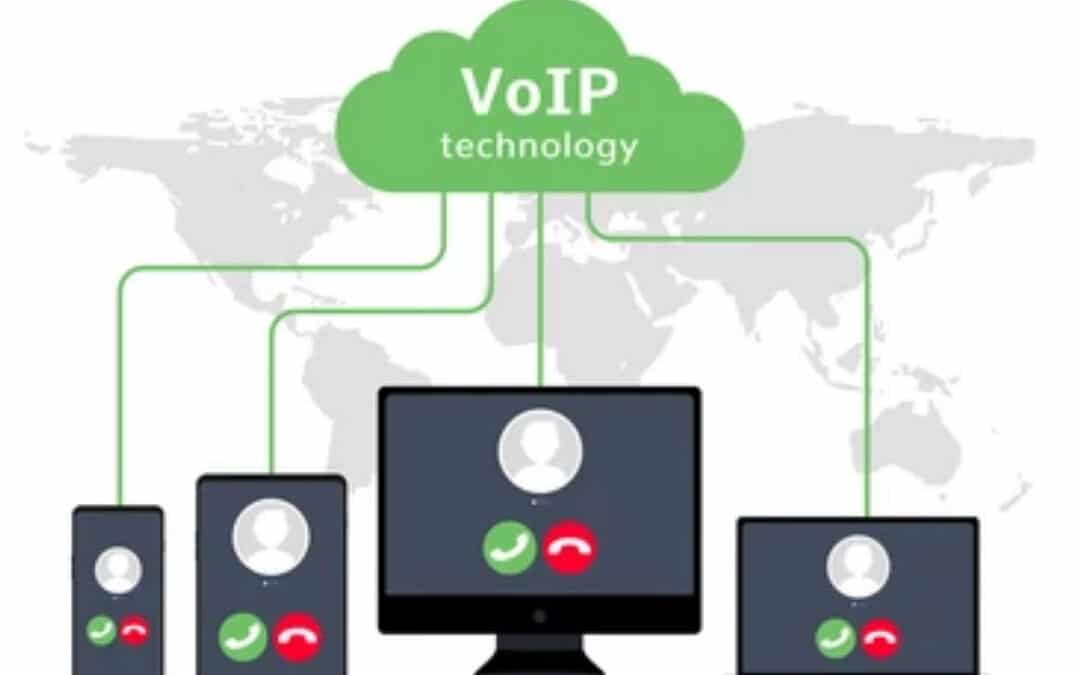As the global workforce continues to embrace remote workstations and mobile access to communication, VoIP phone systems are fast becoming a vital part of how enterprises conduct business. While many organizations may feel intimidated by jumping into new technology, VoIP phones offer affordability, flexibility, innovation, and adaptability to legacy systems, making it easier to bridge the gap between the world of yesterday and the world of tomorrow.
What is a VoIP Phone System?
VoIP refers to phones that use voice over internet protocol to communicate. VoIP is also known as IP telephony. All VoIP phones use a broadband internet connection instead of traditional analog phone lines to transmit communication, such as calls, voicemail, email, text, and more. VoIP phone systems convert signals into digital data sent over the internet using a router. VoIP phones allow users to place calls and other forms of communication through a computer, a VoIP phone, or even a traditional phone connected to a special adapter. High-speed internet is required for VoIP to work. Typical broadband connections include cable modems, digital subscriber lines (DSL), or local area networks. If using VoIP over a computer, users will need to simply install some software and include a microphone and speaker, which most computers already have. Most VoIP computer users take advantage of wireless headsets for improved sound quality and the ability to multitask with several applications and platforms.
VoIP vs. Telephone Lines
Originally called Post Office Telephone Service in the old days when post office workers functioned as phone operators to relay phone calls, POTS now stands for Plain Old Telephone Service or Public Switched Telephone Network (PSTN). POTS utilizes a traditional analog voice transmission system. Analog phone calls are electric signals sent to the recipient over copper wires. Traditional POTS office phone lines use hardware to run the primary rate interface (PRI) on the integrated services digital network (ISDN), a set of communication standards for transmitting communications over the PSTN infrastructure.
A typical private branch exchange (PBX) system uses traditional analog phone cables and an on-premises PBX server. The PBX system can provide multiple phone lines. VoIP technology transmits communications through three types of VoIP phones: IP PBX, fully virtual VoIP, and hybrid VoIP.
- IP PBX: Internet Protocol PBX uses the internet to route communications through an organization’s VoIP networks and the PSTN system. No analog phone lines are used.
- Fully Virtual VoIP: Also known as a “softphone setup,” this type of VoIP setup only uses the internet and phone system software. Cables, desk phones, and other hardware elements are eliminated. All communication is accessed through apps on an internet browser. Users can utilize several devices like computers, tablets, and even smartphones.
- Hybrid VoIP: Bridging the gap between traditional phone lines and VoIP, hybrid VoIP utilizes an organization’s existing analog system as the foundation while adding internet capabilities. This method allows enterprises to transition from traditional systems to more advanced VoIP technology.
Pros and Cons of VoIP Phone Systems
VoIP phone systems offer all the same call options PBX systems provide, such as multiple lines, call forwarding, call waiting, conference calling, and voicemail. With a good internet connection, VoIP technology offers high-quality clarity and continuity during calls. While VoIP phone systems have several advantages over PBX systems, organizations need to weigh the pros and cons to determine the most suitable fit.
Pros
Wide Range of Uses
Beyond upholding standard phone services like a POTS system, VoIP systems can also be utilized as network deployments. Organizations can pair their phone system with several diverse business applications, such as customer relationship management (CRM) software, integrated email, and text messaging. With so many tools at their disposal, enterprises can interact with customers more efficiently.
Mobility
Remote work is increasing across the global workforce. VoIP phone systems allow employees to log in via the system’s web interface from anywhere worldwide as long as they have internet access. There’s no need to set up physical telephone hardware to get a remote office up and running. Reducing overhead costs like office space can help streamline the operational budget for many enterprises. If employees switch devices, they can still keep the same number.
Scalability
An organization’s workforce can fluctuate. VoIP phone systems can have phone lines added or subtracted based on demand. With scalable IP telephony solutions, installing or removing physical phone lines and hardware is no longer a concern.
Adaptable Integration
For organizations looking to increase their legacy systems’ capabilities, IP telephony can
be added to them easily. IP solutions are designed to be flexible, keeping everything the same while increasing functionality and productivity. For instance, faxes can be sent and received via email. IP phone systems also improve the speed of data transmission.
Multimedia Communication
VoIP phones go beyond simple voice-to-voice connections, offering a vast array of communication capabilities. With VoIP phone systems, organizations can effectively use video and conference calls to conduct business worldwide. VoIP also allows for multitasking. Enterprises can talk, text, chat, and send documents all at the same time!
Bandwidth Efficiency
VoIP phone systems utilize voice activation detection (VAD) to compress silent data where possible. Voice-to-voice calls become more cost-effective as IP telephony systems efficiently allocate bandwidth.
Lower Costs
VoIP phone systems can be installed and maintained by in-house network engineers. With IP telephony, there are no proprietary hardware or software updates to deal with. The scalability of VoIP also means that you only pay for the data you use. Traditional phone lines require you to pay for all installed lines, even if you aren’t actively using them. Also, long-distance and international phone calls are only a fraction of the price of traditional landlines. For enterprises that use VoIP, long-distance and international phone calls amount to nearly half the costs.
Cons
Dependant on Internet Connection
If internet service is disrupted, calls and communication won’t be available. With weak signals, there can be issues with latency—the ability for data to get from one point to another. Remote workers must have access to strong, consistent internet connections for their VoIP phones to work properly.
Requires Adequate Bandwidth
When data is transferred over an internet connection, it requires bandwidth—the amount of data that can be transferred in a given amount of time. VoIP phones need bandwidth to deliver quality calls and communication—the higher the bandwidth, the better the quality.
Sustained Power
While many VoIP devices can function wirelessly, their power source must be monitored. They all require electricity. If the power goes out, so does communication. For those employees who set up remote workstations or are looking to conduct work on public transit or an airplane, it’s a good idea to carry an external power source to keep communication up and running.
Choosing the Right VoIP Provider
With over forty-two years of experience, Cynergy Technology can analyze your current PBX architecture and assist you in integrating a VoIP phone solution that best suits your organization’s needs. The right IP telephony solution can give you a competitive edge today while giving you the tools needed to scale for tomorrow. With nearly fifty technical, sales, and administrative professionals, Cynergy Technology has what it takes to help your enterprise seamlessly transition into the modern world. Contact our team of experts today for a free consultation.







